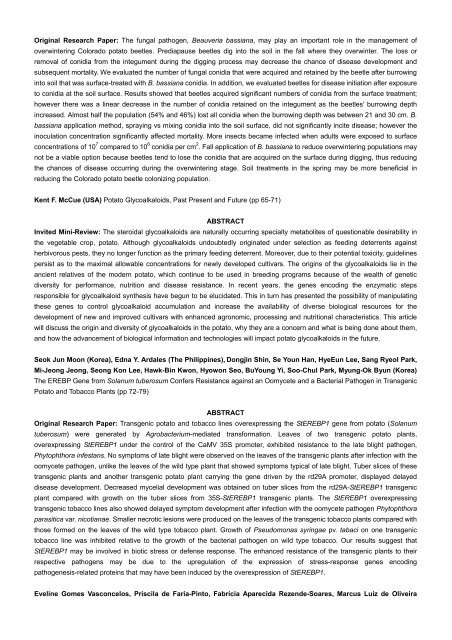Fruit, Vegetable and Cereal Science and Biotechnology
Fruit, Vegetable and Cereal Science and Biotechnology
Fruit, Vegetable and Cereal Science and Biotechnology
Create successful ePaper yourself
Turn your PDF publications into a flip-book with our unique Google optimized e-Paper software.
Original Research Paper: The fungal pathogen, Beauveria bassiana, may play an important role in the management of<br />
overwintering Colorado potato beetles. Prediapause beetles dig into the soil in the fall where they overwinter. The loss or<br />
removal of conidia from the integument during the digging process may decrease the chance of disease development <strong>and</strong><br />
subsequent mortality. We evaluated the number of fungal conidia that were acquired <strong>and</strong> retained by the beetle after burrowing<br />
into soil that was surface-treated with B. bassiana conidia. In addition, we evaluated beetles for disease initiation after exposure<br />
to conidia at the soil surface. Results showed that beetles acquired significant numbers of conidia from the surface treatment;<br />
however there was a linear decrease in the number of conidia retained on the integument as the beetles’ burrowing depth<br />
increased. Almost half the population (54% <strong>and</strong> 46%) lost all conidia when the burrowing depth was between 21 <strong>and</strong> 30 cm. B.<br />
bassiana application method, spraying vs mixing conidia into the soil surface, did not significantly incite disease; however the<br />
inoculation concentration significantly affected mortality. More insects became infected when adults were exposed to surface<br />
concentrations of 10 7 compared to 10 6 conidia per cm 2 . Fall application of B. bassiana to reduce overwintering populations may<br />
not be a viable option because beetles tend to lose the conidia that are acquired on the surface during digging, thus reducing<br />
the chances of disease occurring during the overwintering stage. Soil treatments in the spring may be more beneficial in<br />
reducing the Colorado potato beetle colonizing population.<br />
Kent F. McCue (USA) Potato Glycoalkaloids, Past Present <strong>and</strong> Future (pp 65-71)<br />
ABSTRACT<br />
Invited Mini-Review: The steroidal glycoalkaloids are naturally occurring specialty metabolites of questionable desirability in<br />
the vegetable crop, potato. Although glycoalkaloids undoubtedly originated under selection as feeding deterrents against<br />
herbivorous pests, they no longer function as the primary feeding deterrent. Moreover, due to their potential toxicity, guidelines<br />
persist as to the maximal allowable concentrations for newly developed cultivars. The origins of the glycoalkaloids lie in the<br />
ancient relatives of the modern potato, which continue to be used in breeding programs because of the wealth of genetic<br />
diversity for performance, nutrition <strong>and</strong> disease resistance. In recent years, the genes encoding the enzymatic steps<br />
responsible for glycoalkaloid synthesis have begun to be elucidated. This in turn has presented the possibility of manipulating<br />
these genes to control glycoalkaloid accumulation <strong>and</strong> increase the availability of diverse biological resources for the<br />
development of new <strong>and</strong> improved cultivars with enhanced agronomic, processing <strong>and</strong> nutritional characteristics. This article<br />
will discuss the origin <strong>and</strong> diversity of glycoalkaloids in the potato, why they are a concern <strong>and</strong> what is being done about them,<br />
<strong>and</strong> how the advancement of biological information <strong>and</strong> technologies will impact potato glycoalkaloids in the future.<br />
Seok Jun Moon (Korea), Edna Y. Ardales (The Philippines), Dongjin Shin, Se Youn Han, HyeEun Lee, Sang Ryeol Park,<br />
Mi-Jeong Jeong, Seong Kon Lee, Hawk-Bin Kwon, Hyowon Seo, BuYoung Yi, Soo-Chul Park, Myung-Ok Byun (Korea)<br />
The EREBP Gene from Solanum tuberosum Confers Resistance against an Oomycete <strong>and</strong> a Bacterial Pathogen in Transgenic<br />
Potato <strong>and</strong> Tobacco Plants (pp 72-79)<br />
ABSTRACT<br />
Original Research Paper: Transgenic potato <strong>and</strong> tobacco lines overexpressing the StEREBP1 gene from potato (Solanum<br />
tuberosum) were generated by Agrobacterium-mediated transformation. Leaves of two transgenic potato plants,<br />
overexpressing StEREBP1 under the control of the CaMV 35S promoter, exhibited resistance to the late blight pathogen,<br />
Phytophthora infestans. No symptoms of late blight were observed on the leaves of the transgenic plants after infection with the<br />
oomycete pathogen, unlike the leaves of the wild type plant that showed symptoms typical of late blight. Tuber slices of these<br />
transgenic plants <strong>and</strong> another transgenic potato plant carrying the gene driven by the rd29A promoter, displayed delayed<br />
disease development. Decreased mycelial development was obtained on tuber slices from the rd29A-StEREBP1 transgenic<br />
plant compared with growth on the tuber slices from 35S-StEREBP1 transgenic plants. The StEREBP1 overexpressing<br />
transgenic tobacco lines also showed delayed symptom development after infection with the oomycete pathogen Phytophthora<br />
parasitica var. nicotianae. Smaller necrotic lesions were produced on the leaves of the transgenic tobacco plants compared with<br />
those formed on the leaves of the wild type tobacco plant. Growth of Pseudomonas syringae pv. tabaci on one transgenic<br />
tobacco line was inhibited relative to the growth of the bacterial pathogen on wild type tobacco. Our results suggest that<br />
StEREBP1 may be involved in biotic stress or defense response. The enhanced resistance of the transgenic plants to their<br />
respective pathogens may be due to the upregulation of the expression of stress-response genes encoding<br />
pathogenesis-related proteins that may have been induced by the overexpression of StEREBP1.<br />
Eveline Gomes Vasconcelos, Priscila de Faria-Pinto, Fabrícia Aparecida Rezende-Soares, Marcus Luiz de Oliveira
















